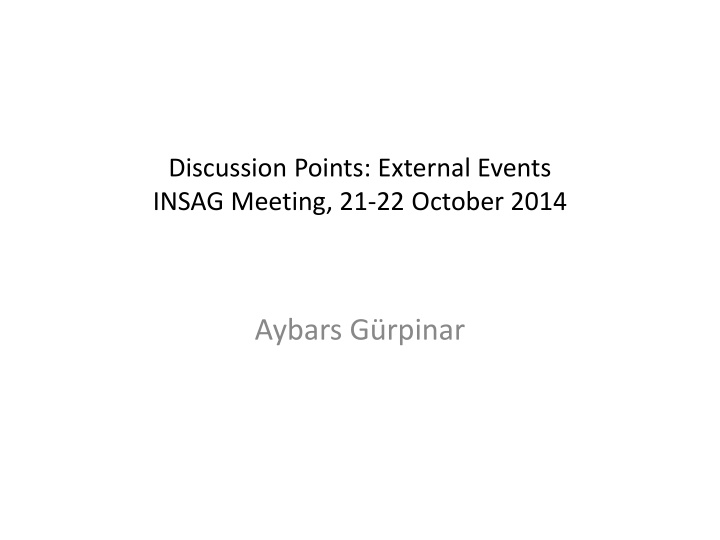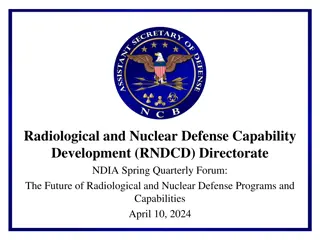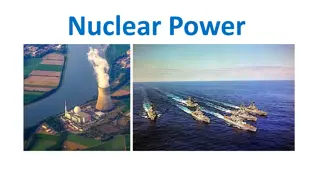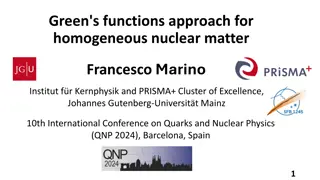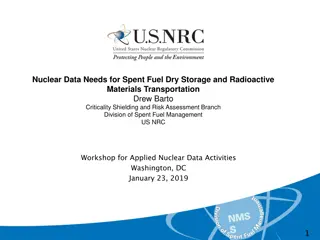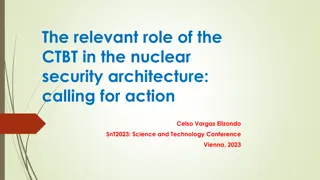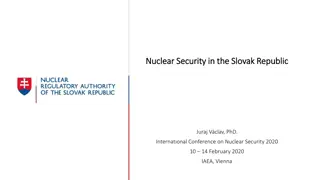Nuclear Safety Conference Discussion Points
Discussion points from an INSAG meeting in October 2014 addressing key aspects of nuclear safety, including Defense in Depth principles, site selection considerations, institutional issues for newcomer countries, and dealing with Beyond Design Basis Events. The content emphasizes the importance of robust safety measures, emergency planning, and the need for specialized knowledge in ensuring nuclear safety across various operational scenarios.
Download Presentation

Please find below an Image/Link to download the presentation.
The content on the website is provided AS IS for your information and personal use only. It may not be sold, licensed, or shared on other websites without obtaining consent from the author.If you encounter any issues during the download, it is possible that the publisher has removed the file from their server.
You are allowed to download the files provided on this website for personal or commercial use, subject to the condition that they are used lawfully. All files are the property of their respective owners.
The content on the website is provided AS IS for your information and personal use only. It may not be sold, licensed, or shared on other websites without obtaining consent from the author.
E N D
Presentation Transcript
Discussion Points: External Events INSAG Meeting, 21-22 October 2014 Aybars G rpinar
Contents Defense in Depth Institutional DiD Beyond Design Basis EE EE, BDB, DEC and severe Accidents EE PSA Site parameters and SAR Concurrent EEs Security Interface
Defense in Depth Site Selection provides a significant part of the overall DiD (SF Paragraph 3.32) On the prevention side, a good site would mean one that is not exposed to external hazards frequently. Although external hazard design combination constitutes the protection that the NPP has against EEs, due to the large uncertainties associated with EEs, the frequent exposure to EEs of an NPP means that one layer of DiD is being challenged.
Defense in Depth On the mitigation side, the possibilities that the site provides for the establishment and implementation of Emergency Plan/Measures can be considered part of DiD. A favorable demography, robust infrastructure and good dispersion characteristics in the atmospheric and aquatic media are the main factors. This needs to be emphasized in the site selection process especially for newcomers.
Defense in Depth The tacit assumption in the DiD is that the first barrier is disabled first, then the second etc. This is because the third level (containment) is there because we postulate a LOCA although the primary circuit is designed with the best tools that we have. What happens when we lose the containment (because of an EE) before the accident? Should there be an increase for DBEEs as we go to higher levels of DiD? Should we make sure that SSCs involved in DiD Level 3 are more robust than those whose failure may lead to an accident?
Institutional Issues For a newcomer country, in general the NEPIO lacks knowhow in EEs and site characterization and the specialized institutions in the country related to EEs, lack knowhow on the discipline and rigor of nuclear safety approaches including QA programs and procedures. This creates the basis for an awkward relationship. If not consciously considered and rectified, this may continue for a long time and become an issue also for mature operators and regulators.
Beyond Design Basis EE For operating NPPs, BDB Earthquakes have been considered in the USA and then in Europe because of the change in hazard perception, change in methods, regulations and sometimes events exceeding the DB. The IAEA was asked to review the seismic safety of the NPPs in Eastern European countries in the 1990s. At this time BDB Earthquakes were considered also for these plants.
Beyond Design Basis EE Then at the end of 1990s and beginning of 2000s (with the hopes for a nuclear renaissance), it was felt that instead of re- evaluation and possibly upgrading of existing NPPs (which is costly), the concept of BDBE would be integrated into the design of new NPPs. EUR requires a margin of 40% over design, USNRC requires the demonstration of a factor of 1.67 for the plant HCLPF value (both for seismic events).
Beyond Design Basis EE After Fukushima, regulators are rightly thinking of BDB evaluations for other EEs in order to understand and avoid potential cliff edges. The practice from the experience of evaluating existing NPPs (mainly for seismic loads) was always supervised by the regulators but was not always part of the licensing process.
EE, BDB, DEC and Severe Accidents Based on PIEs, Accidents and Severe Accidents are postulated to design plant SSCs and determine management procedures that can cope with these under prescribed safety criteria. EEs are neither PIEs nor accidents. They constitute a separate sub-set of design bases which may, in many cases, govern the design of safety related SSCs. Up to the Design Basis EE level, their combination with Accidents is generally well understood and regulated. This is at least the case for seismic events where seismic categorization defines the above mentioned relationship.
EE, BDB, DEC and Severe Accidents For non-seismic EEs even up to the design basis level the combinations are not clear. Sometimes this is done using the seismic analogy. For EEs which are beyond design (or DEC) there is little guidance on acceptance criteria or combinations. Practice is to use the experience from applications to existing NPPs which may differ from country to country.
EE PSA In PSAs EEs are known to be significant contributors to CDF and LERF. The tendency maybe that this trend will continue and further increase because the new designs will decrease internal event related CDs and external events are associated with very large uncertainties that are difficult to decrease. Therefore it will be difficult to require to keep EE contribution to CD below certain thresholds.
EE PSA EE related probabilities are generally calculated using scenario based, model based and phenomenological approaches. This is because related historical data to calculate event frequencies is insufficient. They are frequency based only to a limited extent. On the other hand internal PSA is generally based on frequency dependent failure rates (e.g. equipment failure, operator mistake, maintenance error etc). How legitimate is it to compare these probabilities?
EE PSA Furthermore EEs generally go to CD in one or two steps (singletons, doubletons) whereas internal failures get to 10-5 levels by the product of several larger frequencies (e.g. 10-1 times 10-2 times 10-2). This means that the estimates of the individual internal event failures and therefore the CDF (their product) is much more robust. This may also contribute to the difficulties of a direct comparison of internal and external event associated CD and LER.
Site parameters and SAR Chapter 2 of the SAR (in RG 1.70 Format) provides information on all the site related parameters that need to be considered in design and management procedures. Each site parameter should lead to an action item in one or more future chapters of the SAR. There is no organic and effective mechanism to ensure this link at the moment. One way to establish this would be to require a matrix between sections of Chapter 2 (addressing different site related parameters) to other sections of the SAR which uses the particular site related parameter in the design of the SSCs or management procedures. While Chapter 3 captures a significant part of this, there are other chapters that uses (or should use) site related parameters.
Concurrent EEs IAEA NS-R-3 Paragraph 2.29. The external zone for a proposed site shall be established with account taken of the potential for radiological consequences for people and the feasibility of implementing emergency plans, and of any external events or phenomena that may hinder their implementation. Note that: P[EE/LER] = Contribution of EE to LERF which is generally very significant.
Security Interface In the Safety domain Sabotage of NNPs is considered as a DEC large commercial ACC. It seems that the relations between safety and security depend on the country. Not always optimum. The IAEA has no guidance to provide to MS on ACC for example.
